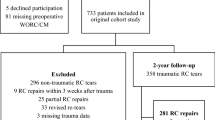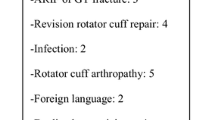Abstract
Purpose
The purpose of this study was to compare the clinical and magnetic resonance imaging (MRI) results between early and delayed operative treatment in patients with traumatic rotator cuff tears (RCT).
Methods
Thirty-five patients with a traumatic RCT who have been treated surgically during a 4-year period were included in the study. The results of early versus delayed repair of traumatic rotator RCT were assessed using the Constant and UCLA scores. In addition, all patients underwent a postoperative MRI to evaluate repair integrity. Early repair (within 3 weeks) was performed in 15 patients (group I) and delayed repair (after 3 weeks) in the rest 20 patients (group II). The time interval between injury and operation was 12 and 131 days on average for group I and II, respectively.
Results
Follow-up time was 34 and 38 months for group I and II, respectively. Postoperatively, the UCLA score was 31 and 26 (P < 0.05) for group I and II, respectively. The Constant score was 82 and 70 (P < 0.05) for group I and II, respectively. Range of motion was significantly better in group I. According to MRI, 5 patients (33%) in the group I and 7 patients (35%) in the group II had a retear.
Conclusions
Early repair of a traumatic RCT provides better results in terms of shoulder function in comparison with a delayed repair. A delayed diagnosis of a traumatic RCT leads to difficulties in surgery and less good results.
Level of evidence
Level III, therapeutic, retrospective, comparative study.
Similar content being viewed by others
References
Amstutz HC, Sew Hoy AL, Clarke IC (1981) UCLA anatomic total shoulder arthroplasty. Clin Orthop Rel Res 155:7–20
Basset RW, Cofield RH (1983) Acute tears of the rotator cuff. The timing of surgical repair. Clin Orthop Rel Res 175:18–24
Boileau P, Brassart N, Watkinson DJ, Carles M, Hatzidakis AM, Krishnan SG (2005) Arthroscopic repair of full-thickness tears of the supraspinatus: does the tendon really heal? J Bone Joint Surg Am 87:1229–1240
Braune C, von Eisenhart-Rothe R, Welsch F, Teufel M, Jaeger A (2003) Mid-term results and quantitative comparison of postoperative shoulder function in traumatic and non-traumatic rotator cuff tears. Arch Orthop Trauma Surg 123:419–424
Constant CR, Murley AHG (1987) A clinical method of functional assessment of the shoulder. Clin Orthop Rel Res 214:160–164
Galatz LM, Rothermich SY, Zaeqel M, Silva MJ, Havlioglu N, Thomopoulos S (2005) Delayed repair of tendon to bone injuries leads to decreased biomechanical properties and bone loss. J Orthop Res 23:1441–1447
Gerber C, Hersche O, Farron A (1996) Isolated rupture of the subscapularis tendon. J Bone Joint Surg Am 78:1015–1023
Gimbel JA, Van Kleunen JP, Lake SP, Williams GR, Soslowsky LJ (2007) The role of repair tension on tendon to bone healing in an animal model of chronic rotator cuff tears. J Biomech 40:561–568
Green A (2003) Chronic massive rotator cuff tears: evaluation and management. JAAOS 11:321–331
Ide J, Tokiyoshi A, Hirose J, Mizuta H (2007) Arthroscopic repair of traumatic combined rotator cuff tears involving the subscapularis tendon. J Bone Joint Surg Am 89:2378–2388
Klepps S, Bishop J, Lin J (2004) Prospective evaluation of the effect of rotator cuff integrity on the outcome of open rotator cuff repairs. Am J Sports Med 32:1716–1722
Lafosse L, Brozska R, Toussaint B, Gobezie R (2007) The outcome ans structural integrity of arthroscopic rotator cuff repair with use of the double-row suture anchor technique. J Bone Joint Surg Am 89:1533–1541
Lähteenmäki HE, Virolainen P, Hiltunen A, Heikkilä J, Nelimarkka OI (2006) Results of early operative treatment of rotator cuff tears with acute symptoms. J Should Elb Surg 15:148–153
Lichtenberg S, Liem D, Magosch P, Habermeyer P (2006) Influence of tendon healing after arthroscopic rotator cuff repair on clinical outcome using single-row Mason-Allen suture technique: a prospective, MRI controlled study. Knee Surg Sports Traumatol Arthrosc 14:1200–1206
Liem D, Bartl C, Lichtenberg S, Magosch P, Habermeyer P (2007) Clinical outcome and tendon integrity of arthroscopic versus mini-open supraspinatus tenson repair: a magnetic resonance imaging controlled matched-pair analysis. Arthroscopy 23:514–521
Loew M, Habermeyer P, Wiedmann E, Rickert M, Gohlke F (2000) Recommendations for diagnosis and legal assessment of traumatic rotator cuff tears. Unfallchirurgv 103:417–426
Namdari S, Frank Henn R III, Green A (2008) Traumatic anterosuperior rotator cuff tears: the outcome of open surgical repair. J Bone Joint Surg Am 90:1906–1913
Nich C, Muetschler C, Vandenbussche E, Augereau B (2009) Long-term clinical and MRI results of open repair of the supraspinatus tendon. Clin Orthop 467:2613–2622
Owen RS, Iannoti JP, Kneeland JB, Dalinka MK, Deren JA, Oleaga L (1993) Shoulder after surgery: MR imaging with surgical validation. Radiology 186:443–447
Post M, Silver R, Singh M (1983) Rotator cuff tear. Diagnosis and treatment. Clin Orthop Relat Res 173:78–91
Sørensen AK, Bak K, Krarup AL, Thune CH, Nygaard M, Jørgensen U, Sloth C, Torp-Pedersen S (2007) Acute rotator cuff tear: do we miss the early diagnosis? A prospective study showing a high incidence of rotator cuff tears after shoulder trauma. J Should Elbow Surg 16:174–180
Warner JJ, Higgins L, Parsons IM 4th, Dowdy P (2001) Diagnosis and treatment of anterosuperior cuff tears. J Should Elbow Surg 10:37–46
Woertlet K (2007) Mutlimodality imaging of the postoperative shoulder. Eur Radiol 17:3038–3055
Yoo CJ, Ahn JH, Koh KH, Lim KS (2009) Rotator cuff integrity after arthroscopic repair for large tears with less than optimal footprint coverage. Arthroscopy 25:1093–1100
Zanetti M, Hodler J (2006) MR imaging of the shoulder after surgery. Radiol Clin N Am 44:537–551
Author information
Authors and Affiliations
Corresponding author
Rights and permissions
About this article
Cite this article
Hantes, M.E., Karidakis, G.K., Vlychou, M. et al. A comparison of early versus delayed repair of traumatic rotator cuff tears. Knee Surg Sports Traumatol Arthrosc 19, 1766–1770 (2011). https://doi.org/10.1007/s00167-011-1396-1
Received:
Accepted:
Published:
Issue Date:
DOI: https://doi.org/10.1007/s00167-011-1396-1




